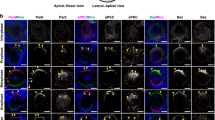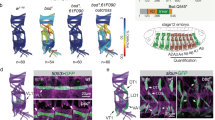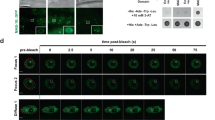Abstract
Wnt signalling regulates β-catenin-dependent developmental processes through the Dishevelled protein (Dsh). Dsh regulates two distinct pathways, one mediated by β-catenin and the other by Jun kinase (JNK). We have purified a Dsh-associated kinase from Drosophila that encodes a homologue of Caenorhabditis elegans PAR-1, a known determinant of polarity during asymmetric cell divisions. Treating cells with Wnt increases endogenous PAR-1 activity coincident with Dsh phosphorylation. PAR-1 potentiates Wnt activation of the β-catenin pathway but blocks the JNK pathway. Suppressing endogenous PAR-1 function inhibits Wnt signalling through β-catenin in mammalian cells, and Xenopus and Drosophila embryos. PAR-1 seems to be a positive regulator of the β-catenin pathway and an inhibitor of the JNK pathway. These findings show that PAR-1, a regulator of polarity, is also a modulator of Wnt–β-catenin signalling, indicating a link between two important developmental pathways.
This is a preview of subscription content, access via your institution
Access options
Subscribe to this journal
Receive 12 print issues and online access
$209.00 per year
only $17.42 per issue
Buy this article
- Purchase on Springer Link
- Instant access to full article PDF
Prices may be subject to local taxes which are calculated during checkout






Similar content being viewed by others
References
Cadigan, K. M. & Nusse, R. Wnt signalling: a common theme in animal development. Genes Dev. 11, 3286–3305 (1997).
Brown, J. D. & Moon, R. T. Wnt signalling: why is everything so negative? Curr. Opin. Cell Biol. 10, 182–187 (1998).
Kinzler, K. W. & Vogelstein, B. Lessons from hereditary colorectal cancer. Cell 87, 159–170 (1996).
Peifer, M. & Polakis, V. Wnt signalling in oncogenesis and embryogenesis – a look outside the nucleus. Science 287, 1606–1609 (2000).
Boutros, M., Paricio, N., Strutt, D. I. & Mlodzik, M. Dishevelled activates JNK and discriminates between JNK pathways in planar polarity and wingless signalling. Cell 94, 109–118 (1998).
Axelrod, J. D., Miller, J. R., Shulman, J. M., Moon, R. T. & Perrimon, N. Differential recruitment of Dishevelled provides signalling specificity in the planar cell polarity and Wingless signalling pathways. Genes Dev. 12, 2610–2622 (1998).
Li, L. et al. Dishevelled proteins lead to two signalling pathways: regulation of LEF1 and cJun N-terminal kinase in mammalian cells. J. Biol. Chem. 274, 129–134 (1999).
Klingensmith, J., Nusse, R. & Perrimon, N. The Drosophila segment polarity gene dishevelled encodes a novel protein required for response to the wingless signal. Genes Dev. 8, 118–130 (1994).
Theisen, H. et al. dishevelled is required during wingless signalling to establish both cell polarity and cell identity. Development 120, 347–360 (1994).
Sokol, S. Y., Klingensmith, J., Perrimon, N. & Itoh, K. Dorsalizing and neuralizing properties of Xdsh, a maternally expressed Xenopus homolog of dishevelled. Development 121, 1637–1647 (1995).
Yanagawa, S., van Leeuwen, F., Wodarz, A., Klingensmith, J. & Nusse, R. The Dishevelled protein is modified by wingless signalling in Drosophila. Genes Dev. 9, 1087–1097 (1995).
Lee, J.-S., Ishimoto, A. & Yanagawa, S.-I. Characterization of mouse Dishevelled (Dvl) proteins in Wnt/Wingless signalling pathway. J. Biol. Chem. 274, 21464–21470 (1999).
Guo, S. & Kemphues, K. J. par-1, a gene required for establishing polarity in C. elegans embryos, encodes a putative Ser/Thr kinase that is asymmetrically distributed. Cell 81, 611–620 (1995).
Shulman, J. M., Benton, R. & Johnston, D. S. The Drosophila homolog of C. elegans PAR-1 organizes the oocyte cytoskeleton and directs oskar mRNA localization to the posterior pole. Cell 101, 377–388 (2000).
Tomancak, P. et al. A Drosophila melanogaster homologue of Caenorhabditis elegans par-1 acts at an early step in embryonic-axis formation. Nature Cell Biol. 2, 458–460 (2000).
Cox, D. N., Lu, B., Sun, T.-Q., Williams, L. T. & Jan, Y. N. Drosophila par-1 is required for oocyte differentiation and microtubule organization. Curr. Biol. 11, 75–87 (2001).
Espinosa, L. & Navarro, E. Human serine/threonine protein kinase EMK1: genomic structure and cDNA cloning of isoforms produced by alternative splicing. Cytogenet. Cell Genet. 81, 278–282 (1998).
van Leeuwen, F., Samos, C. H. & Nusse, R. Biological activity of soluble wingless protein in cultured Drosophila imaginal disc cells. Nature 368, 342–344 (1994).
Peifer, M., Sweeton, D., Casey, M. & Wieschaus, E. Wingless signal and zeste-white 3 kinase trigger opposing changes in the intracellular distribution of armadillo. Development 120, 369–380 (1994).
Papkoff, J., Rubinfeld, B., Schryver, B. & Polakis, P. Wnt-1 regulates free pools of catenins and stabilizes APC–catenin complexes. Mol. Cell. Biol. 16, 2128–2134 (1996).
Salic, A., Lee, E., Mayer, L. & Kirschner, M. W. Control of β-catenin stability: reconstitution of the cytoplasmic steps of the wnt pathway in Xenopus egg extracts. Mol. Cell 5, 523–532 (2000).
Molenaar, M. et al. XTcf-3 transcription factor mediates β-catenin-induced axis formation in Xenopus embryos. Cell 86, 391–399 (1996).
Behrens, J. et al. Functional interaction of β-catenin with the transcription factor LEF-1. Nature 382, 638–642 (1996).
Huber, O. et al. Nuclear localization of β-catenin by interaction with transcription factor LEF-1. Mech. Dev. 59, 3–10 (1996).
Korinek, V. et al. Constitutive transcriptional activation by a β-catenin–Tcf complex in APC−/− colon carcinoma. Science 275, 1784–1787 (1997).
Morin, P. J. et al. Activation of β-catenin–Tcf signalling in colon cancer by mutations in β-catenin or APC. Science 275, 1787–1790 (1997).
Hsu, S. C., Galceran, J. & Grosschedl, R. Modulation of transcriptional regulation by LEF-1 in response to Wnt-1 signalling and association with β-catenin. Mol. Cell. Biol. 18, 4807–4818 (1998).
Zeng, L. et al. The mouse Fused locus encodes Axin, an inhibitor of the Wnt signalling pathway that regulates embryonic axis formation. Cell 90, 181–192 (1997).
Sakanaka, C., Weiss, J. H. & Williams, L. T. Bridging of β-catenin and glycogen synthase kinase-3β by Axin and inhibition of β-catenin mediated transcription. Proc. Natl Acad. Sci. USA 95, 3020–3023 (1998).
Ikeda, S. et al. Axin, a negative regulator of the Wnt signalling pathway, forms a complex with GSK-3β and β-catenin and promotes GSK-3β-dependent phosphorylation of β-catenin. EMBO J. 17, 1371–1784 (1998).
Wallingford, J. B. et al. Dishevelled controls cell polarity during Xenopus gastrulation. Nature 405, 81–85 (2000).
Heisenberg, C.-P. et al. Silberblick/Wnt11 mediates convergent extension movements during zebrafish gastrulation. Nature 405, 76–81 (2000).
Moon, R. T. & Kimelman, D. X. From cortical rotation to organizer gene expression: toward a molecular explanation of axis specification in Xenopus. BioEssays 20, 536–545 (1998).
Christian, J. L., McMahon, J. A., McMahon, A. P. & Moon, R. T. Xwnt-8, a Xenopus wnt-1/int-1 related gene responsive to mesoderm inducing growth factors, may play a role in ventral mesodermal patterning during early development. Development 111, 1045–1055 (1991).
Deardorff, M. A., Tan, C., Conrad, L. J. & Klein, P. S. Frizzled-8 is expressed in the Spemann organizer and plays a role in early morphogenesis. Development 125, 2687–2700 (1998).
Sokol, S. Y. Analysis of Dishevelled signalling pathways during Xenopus development. Curr. Biol. 6, 1456–1467 (1996).
Peters, J. M., McKay, R. M., McKay, J. P. & Craff, J. M. Casein kinase I transduces Wnt signals. Nature 401, 345–350 (1999).
He, X., Saint-Jeannet, J.-P., Woodgett, J. R., Varmus, H. E. & Dawid, I. Glycogen synthase kinase-3 and dorsoventral patterning in Xenopus embryos. Nature 374, 617–622 (1995).
Pierce, S. B. & Kimelman, D. Regulation of Spemann organizer formation by the intracellular kinase Xgsk-3. Development 121, 755–765 (1995).
Kennerdell, J. R. & Carthew, R. W. Use of dsRNA-mediated genetic interference to demonstrate that frizzled and frizzled 2 act in the Wingless pathway. Cell 95, 1017–1026 (1998).
Baker, N. E. Embryonic and imaginal requirements for wg, a segment polarity gene in Drosophila. Dev. Biol. 125, 96–108 (1988).
Brand, A. H. & Perrimon, N. Targeted gene expression as a means of altering cell fates and generating dominant phenotypes. Development 118, 401–415 (1993).
Rocheleau, C. E. et al. Wnt signalling and an APC-related gene specify endoderm in early C. elegans embryos. Cell 90, 707–716 (1997).
Thorpe, C. J., Schlesinger, A., Carter, J. C. & Bowerman, B. Wnt signalling polarizes an early C. elegans blastomere to distinguish endoderm from mesoderm. Cell 90, 695–705 (1997).
Sakanaka, C., Leong, P., Xu, L., Harrison, S. D. & Williams, L. T. Casein kinase Iɛ in the Wnt pathway: regulation of β-catenin function. Proc. Natl Acad. Sci. USA 96, 12548–12552 (1999).
Yost, C. et al. GBP, an inhibitor of GSK-3, is implicated in Xenopus development and oncogenesis. Cell 93, 1031–1041 (1998).
Li, L. et al. Axin and Frat1 interact with dvl and GSK, bridging Dvl to GSK in Wnt-mediated regulation of LEF-1. EMBO J. 18, 4233–4240 (1999).
Tsang, M. et al. Isolation and characterization of mouse dishevelled-3. Dev. Dynam. 207, 253–262 (1996).
Reichsman, F., Smith, L. & Cumberlege, S. Glycosaminoglycans can modulate extracellular localization of the Wingless protein and promote signal transduction. J. Cell Biol. 135, 819–827 (1996).
Murphy, J. E. et al. A combinatorial approach to the discovery of efficient cationic peptoid reagents for gene delivery. Proc. Natl Acad. Sci. USA 95, 1517–1522 (1998).
Acknowledgements
We thank J. Fernandez at Rockefeller University for protein sequencing. We are grateful to R. Grosschedl, S. Cumberlege, P. Klein, D. Kessler, R. Zuckermann, M. Milner, R. Carthew and Developmental Studies Hybridoma Band for critical reagents. We appreciate helpful discussions with C. Mello, T. H. Shin, C. Sakanaka, K. Ramer, and D. Yan. We thank M. Wu for the Xenopus injection assay, S. Harrison for critical reading of the manuscript, C. Turk for technical assistance and B. Cheung for administrative assistance. This work was supported partially by funds from the National Institutes of Health-Program of Excellence in Molecular Biology (PO HL43821) and by an unrestricted award from the Howard Hughes Medical Institute.
Author information
Authors and Affiliations
Corresponding author
Supplementary information
Figure S1
Identification of a Dsh-associated kinase from Drosophila embryos and cultured cells. (PDF 252 kb)
Figure S2 Purification and cloning of Dsh-associated kinase from Drosophila embryos.
Figure S3 In vitro and in vivo phosphorylation of Dsh by dPAR-1.
Figure S4 RT-PCR analysis showing expression of three hPAR-1 genes in different human tissues.
Figure S5 Dvl phosphorylation induced by Wnt is sensitive to phosphatase treatment.
Rights and permissions
About this article
Cite this article
Sun, TQ., Lu, B., Feng, JJ. et al. PAR-1 is a Dishevelled-associated kinase and a positive regulator of Wnt signalling. Nat Cell Biol 3, 628–636 (2001). https://doi.org/10.1038/35083016
Received:
Revised:
Accepted:
Published:
Issue Date:
DOI: https://doi.org/10.1038/35083016
This article is cited by
-
The metabolic stress-activated checkpoint LKB1-MARK3 axis acts as a tumor suppressor in high-grade serous ovarian carcinoma
Communications Biology (2022)
-
PP5 (PPP5C) is a phosphatase of Dvl2
Scientific Reports (2018)
-
MARK2/Par1b Insufficiency Attenuates DVL Gene Transcription via Histone Deacetylation in Lumbosacral Spina Bifida
Molecular Neurobiology (2017)
-
Attenuation of synaptic toxicity and MARK4/PAR1-mediated Tau phosphorylation by methylene blue for Alzheimer’s disease treatment
Scientific Reports (2016)
-
Par system components are asymmetrically localized in ectodermal epithelia, but not during early development in the sea anemone Nematostella vectensis
EvoDevo (2015)



